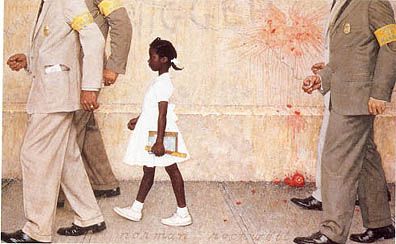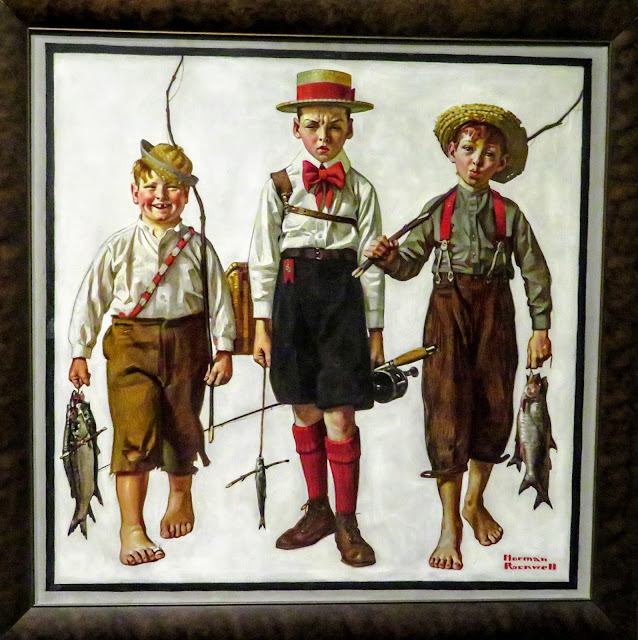We
started out the day with a major attraction!
This is
the Norman Rockwell museum just outside of Stockbridge Massachusetts. Not only is the museum attractive, but so are
the grounds upon which it is situated.
Loved the flowers!
If you
are over the age of 50, you absolutely should know who Norman Rockwell
was. I’m sure that our grandsons never
heard of him…
Rockwell
(1894 – 1978) was an American author, painter and illustrator. His art work enjoyed broad appeal in the USA
because they represented a reflection of American culture. Norman Rockwell was best known for his cover
illustrations for the magazine, The
Saturday Evening Post that he completed over 5 decades. They showed everyday life in the USA.
What
follows is a small selection of some of Rockwell’s works on display at the museum…
This
original of a cover illustration for the August 30, 1947 edition of The Saturday Evening Post is entitled
“Going and Coming”. Like many of
Rockwell’s works, this is a narrative painting in that it’s seasonal and
topical…with a bit of humor thrown in.
This
painting is titled “Marriage License” and it was used as the cover for The Saturday Evening Post’s June 11, 1955
issue. The light on the bride’s dress
indicates their bright future together.
Rockwell used models for his paintings.
In this case, the town clerk used as the model had just lost his
wife…and the painting shows his state of mind.
This is
one of my favorites, a bad habit of the human species that has been greatly exacerbated
by smart phones and social media. Before
technology overwhelmed us, gossip was mostly a local affair…not any
longer! In any case, this painting from
1948 is titled “The Gossips”. It was the
cover illustration for The Saturday
Evening Post’s issue on March 6, 1948.
Reportedly,
the Post’s editor questioned whether
Rockwell’s characters could possibly be real.
The second grouping of Rockwell’s models for the painting was rather
convincing… After the photos, Rockwell’s next rendering of these characters was
in charcoal and graphite on paper. It
was also on display at the museum.
This is
one of Rockwell’s best known illustrations.
“The Runaway” is an illustration of what we would refer to these days as
community policing. This was the cover
for the Post on September 20,
1958. All the attention is focused on
the boy and his situation…
This
painting is unlike any other works I’d seen by Rockwell. Entitled “Strictly a Sharpshooter”, it was
completed as an illustration for a short story by D.D. Beauchamp in the June
1941 issue of American Magazine. In the painting, the gold digging girlfriend
of the young boxer has goaded him into fighting a seasoned veteran of the
sport. When the inexperienced young man
loses, she yells out her rejection of him!
Norman
Rockwell was 84 when he died. At the
time, his vision was failing but he was still painting. This was his last painting, unfinished when
he died. It’s called “John Sergeant and Chief Konkapot”. The painting commemorated a significant event
in Stockbridge’s history… This meeting resulted in a ‘grant’ of land to the
Mohican Nation.
Another
earlier Rockwell painting followed the same theme…races coming together. This earlier painting is titled “New Kids in
the Neighborhood” and it was an illustration for an article written by Jack
Star for Look Magazine’s May 16, 1967
issue entitled “Negro in the Suburbs”.
The article was about the integration of Chicago’s Park Forest
community. It appears the children are
getting acquainted and will probably be playing together very soon…
This
painting is titled “Veterans of Two Wars”.
It was the cover illustration for The
Red Cross Magazine in June of 1918. A
World War I soldier who is about to ship out to the war in Europe stands
between 2 veterans from the Civil War, one from the Confederate Army and the
other from the Union Army… The apparent theme is unity and support for our
veterans.
This
would be a great place to mention 4 of Norman Rockwell’s most famous
paintings. In January of 1941, President
Roosevelt had given a speech about his vision for a postwar world based on 4
basic human freedoms. They were: freedom
of speech; freedom of religion; freedom from want, and; freedom from fear.
Rockwell
had been producing illustrations that supported the war effort but he decided
to do more, illustrating Roosevelt’s 4 freedoms. The government rejected the effort at first
but The Saturday Evening Post
published Rockwell’s 4 paintings and they were immensely popular!
In 1943, the Post and the US Department of
the Treasury launched a joint campaign to sell war bonds and stamps. The Four Freedoms and other related works
went on tour. Traveling to 16 cities, the
exhibition was visited by over a million people who purchased $133,000,000 in
war bonds and stamps…
To learn
more about the speech, Rockwell’s contribution, and to view the paintings, go
to https://www.nrm.org/2012/10/collections-four-freedoms/. I would be surprised if you weren’t familiar
with one or two of them…
This work
is entitled “Home for Christmas” and it was published in McCall’s Magazine in December 1967.
Rockwell’s home and studio were just to the right of that white old
Victorian Hotel. He had another studio
in town for a while as well. It was over
the market in the painting. Note the
light in the window.
This
illustration was for an advertisement for ATO, Inc. the maker of American
LaFrance Fire Engines. It was completed
in 1971. And it’s titled “The New American LaFrance is Here” (Firehouse). All the people in the painting add interest
to the theme. The firehouse is in
Stockbridge but the old LaFrance fire engine was substituted for the actual
fire truck that was built by Ford.
This is
another of Norman Rockwell’s better known paintings. It’s simply titled “The Catch”. It was the cover illustration for Country Gentleman Magazine’s issue on May
3, 1919. Can you see what made the boy
in the middle of the picture so unhappy?
This is the second photo of a pair of paintings. In the first painting, the boys are headed
off to the fishing hole.

This may be Rockwell’s most famous and, at the time, controversial painting. This work is titled “The Problem We All Live With”. This was Rockwell’s first assignment for Look Magazine. A 6 year old African-American girl is being escorted by 4 U.S. Marshals to her first day at an all-white school in New Orleans. The actual integration of New Orleans schools occurred 6 years after the Brown vs. Board of Education ruling.
While
working for The Saturday Evening Post,
Rockwell had been forced to paint out an African-American in an illustration. The Post’s
rule was that African-American’s could only be shown in service industry jobs…
Rockwell seemed to relish the newfound ability to correct the editorial
prejudices in his previous work.
I’ll end
our examples of Norman Rockwell’s paintings with “A Good Scout”. This painting/illustration was done as an
illustration for the Boy Scouts of America’s 1935 calendar and for the cover of
the February 1935 issue of Boy’s Life
Magazine.
Actually,
Rockwell had a very long relationship with the Boy Scouts. He illustrated the Boy Scout Handbook in 1912
and was on the staff of the scout’s Boy’s
Life Magazine until 1917. His
loyalty to the Boy Scouts was unwavering.
He produced illustrations for the group’s annual calendar from 1925 –
1976.
The
Rockwell Museum isn’t all about Norman Rockwell. Other exhibits with a variety of artists
regularly rotate through some of the galleries.
I’ve included 4 varied examples of other artist’s works that were on exhibit
during our visit…
This
painting is titled “Solitude”. It was
completed in 1911 by Maxwell Parish (American 1870 – 1966)
Lemuel
Wilmarth (American 1835 – 1918) painted this sentimental work entitled “The
Sailor’s Return” in 1884.
Carle Van
Loo (French 1705 – 1765) completed this work in 1737. Its title is “A Pasha Having His Mistresses’
Portrait Painted”.
American artist, N.C. Wyeth (1882 – 1945) painted the western themed “The Bear Hunter”
in 1909.
Our first
thought was that this handsome big house on the grounds near the museum had been Norman
Rockwell’s home and that there would be a tour.
We were mistaken. This is the
Linwood House. It was built as a ‘summer
cottage’ by a prominent (and apparently successful) New York attorney. This was among the first of the elegant ‘Berkshire
Cottages’ built in the area. It is not open to the public and it serves as the administrative
offices for the Rockwell Museum…
Norman
Rockwell lived and worked in Stockbridge Massachusetts for the last 25 years of
his life. He called this studio, his “best
studio yet.” This building was
originally located in the backyard of his home on South Street in town. Toward the end of his life, in 1976, Rockwell
left the studio and its contents to the Norman Rockwell Museum. In 1986, the building was cut in half and
moved to the museum’s grounds.
All of
the artist supplies, furniture and decorative items in the studio are original
as given to the museum directly by Norman Rockwell.
We really
enjoyed our visit to the Norman Rockwell Museum! It’s very well done, the docents are very knowledgeable
and Rockwell’s art is ‘comfort food’ for the mind. It was late August when we visited the
museum. We both agree that this was the
busiest tourist attraction that we visited anywhere during our trip!
To learn
more about Norman Rockwell and his prolific artistic endeavors, you can go to https://en.wikipedia.org/wiki/Norman_Rockwell.
The
Norman Rockwell Museum is located at 9 Glendale Road (MA Hwy. 183) in
Stockbridge Massachusetts. They are open
7 days a week. Admission is $20 for
adults, $18 for seniors and $17 for veterans.
Phone: 413-298-4700. Website: https://www.nrm.org/.
That’s about
it for this post… Just click on any of the photos to enlarge them.
Thanks
for stopping by for a tour!
Take
Care, Big Daddy Dave






















How enjoyed this David,. I love Norman Rockwell, What nice there are a museum!always I love his paints ... so much. Thanks by thisDavid. Hugs to you and Laurie!
ReplyDeleteloved it!
ReplyDelete